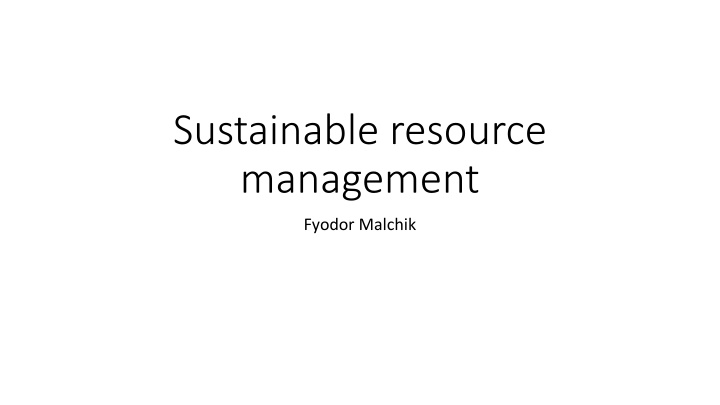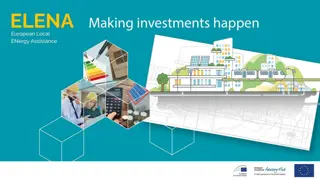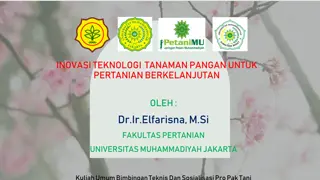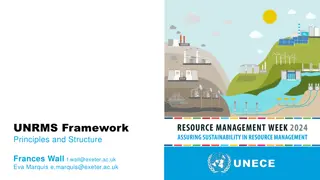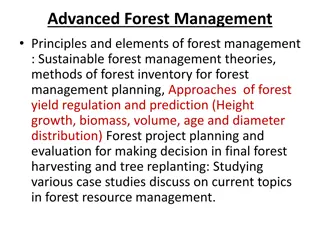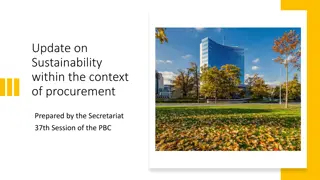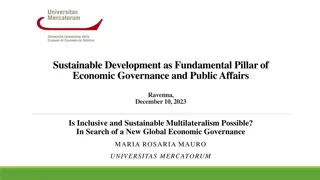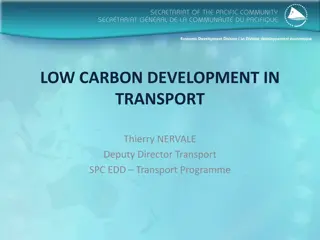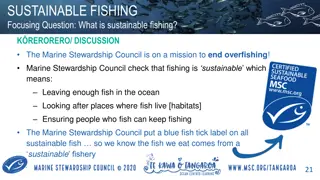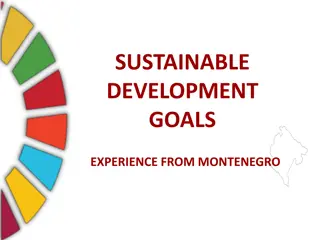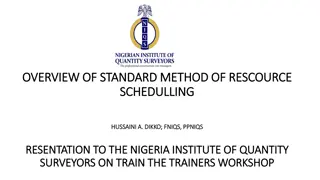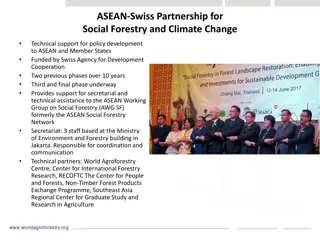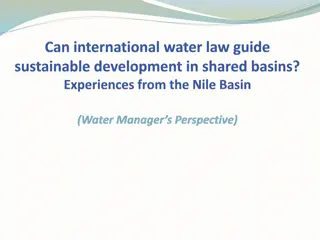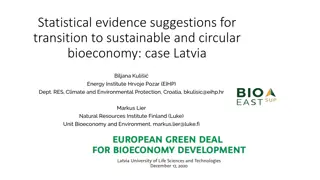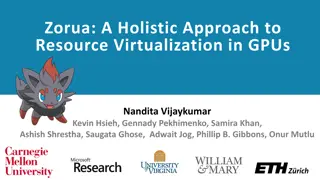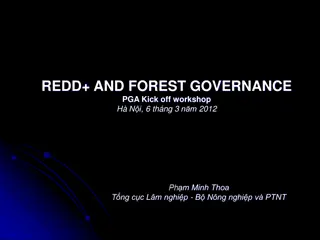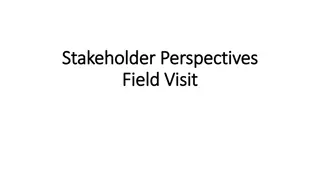Sustainable Resource Management Overview
Managing information for decision-making in land use planning, addressing limits and constraints to sustainable land management, and the concept of sustainable land management pillars. The methodological framework considers biophysical and socioeconomic factors, outlining the agricultural environment in SIDS characterized by distinct farming systems like estate farms and subsistence farms. Explore the characteristics, concerns, and symbiotic relationships within these farming systems.
Download Presentation

Please find below an Image/Link to download the presentation.
The content on the website is provided AS IS for your information and personal use only. It may not be sold, licensed, or shared on other websites without obtaining consent from the author.If you encounter any issues during the download, it is possible that the publisher has removed the file from their server.
You are allowed to download the files provided on this website for personal or commercial use, subject to the condition that they are used lawfully. All files are the property of their respective owners.
The content on the website is provided AS IS for your information and personal use only. It may not be sold, licensed, or shared on other websites without obtaining consent from the author.
E N D
Presentation Transcript
Sustainable resource management Fyodor Malchik
Managing Information for Decision-making in Land Use Planning. Overview of concerns relating to sustainable land use planning and agriculture (SIDS) 2
LIMITS AND CONSTRAINTS TO SUSTAINABLE LIMITS AND CONSTRAINTS TO SUSTAINABLE LAND MANAGEMENT LAND MANAGEMENT Shortages of Arable Land Land Degradation Loss of Agricultural Land to Urbanization Water Shortages Biophysical constraints Socio-economic constraints Changing Political climate 3
CONCEPT OF SUSTAINABLE LAND MANAGEMENT Pillars (UNCED, 1993) Productivity-Maintain or enhance production/services . Security-Reduce the level of production risk. Protection-Protect the potential or natural resources and prevent degradation of soil and water quality. Viable-Be economically viable. Acceptability-Be socially acceptable 4
Methodological Framework BIOPHYSICAL FACTORS SOCIOECONOMIC FACTORS Socio cultural factors POPULATION CHARACTERISTICS ACCESS TO SERVICES, INFRASTRUCTURE, CREDIT, ETC. SOIL WATER VEGETATION OTHERS PRODUCTION SYSTEM NATURAL INFLUENCES SITE USE HUMAN INFLUENCES ACTUAL SITUATION CLIMATE PRODUCTION SYSTEMS POLITICAL INSTITUTIONAL Economic Institutional factors 5
Overview of the SIDS Agricultural Environment characterized by two distinct categories of farming systems that share symbiotic relationships with each other. Estate farms on flat to gentle undulating lands Subsistence farms on the more marginal lands. 6
CHARACTERISTICS OF ESTATE FARMS Commercial and export oriented Mono cropping system on the same plot of land for many years Rely heavily on subsistence farm labour to carry out farming operations Utilizes conventional intensive farming technology. Influence by the political climate (internal and external) 7
CONCERNS Degradation: Declining yields Influence of soil borne and other diseases Declining soil fertility (shortening or elimination fallow periods) Pollution of ground water Soil salinity Globalization 8
CHARACTERISTICS OF SUBSISTENCE FARMING Complex farming systems geared mainly at the domestic market Soil erosion and watershed degradation Relies on commercial farms and other off-farm activities for employment to supplement farm income Multiple cropping system which varies according to season. 9
TYPES OF SUBSISTENCE FARMERS Business approach type farmers Commercial/subsistence type farmers Serious farmers without the means Farmers with resources which are not utilized Farmers by default Way of life farmers (P. Meikle, 1998) 10
ENVIRONMENTAL AND SUSTAINABLE DEVELOPMENT INDICATORS (ESDIs) Since the concept of sustainable development cannot be defined, indicators should be developed to determine levels and duration of sustainability (Zinc and Farshad, 1995). ESDI indicator for Agriculture, land and food Arable and permanent crop land area 11
ISSUES AND CHALLENGES Climatic databases All countries have a network of meteorological stations, to observe and document climate and weather conditions. In areas of difficult access, these stations may be wide apart with a limited number of recording years Time gaps in recording Incompleteness in the range of attributes needed. 12
ISSUES AND CHALLENGES Soil and Terrain Classification criteria and naming of soils differ among countries, making correlations between classifications and countries difficult 13
ISSUES AND CHALLENGES Water resources databases Analysis of data from meteorological stations Repeated measurements of stream flows Assessment of ground water reserves through borehole analysis Amount and types of actual uses being made of the water resources. Some countries may not have the equipment or resources to take these measurements on an on-going basis. Cost of taking some of these measurements may be expensive. 14
ISSUES AND CHALLENGES Land cover and biodiversity databases Geo-referenced information on floral and faunal diversity is scarce Areas of known or inferred archeological value or reflecting typical past land use systems need to be mapped 15
ISSUES AND CHALLENGES Land uses, crop and production systems Land use information is usually consolidated at district level rather than being fully georeferenced. Lack of practical, simple and widely accepted method of describing land uses and production systems is a serious constraint Each land use type should be assessed on its inherent sustainability, on the basis of aset of sustainable indicators 16
ISSUES AND CHALLENGES Land uses, crop and production systems Basic information on the environmental requirements of new cultivars and non-traditional crops is not widely available or may not be available for the conditions in some SIDS. Existing databases are limited with respect to coverage and classes Little management information included in maps 17
ISSUES AND CHALLENGES Economy of inputs and outputs is liable to strong variability Biophysical databases may have a useable lifetime of 20 - 30 years Economic and social databases will normally have to be revised every 5 - 10 years. Limitation in data availability and data quality at all scales, especially those that require substantial ground truthing Lack of METADATA and protocols for data collection. 18
